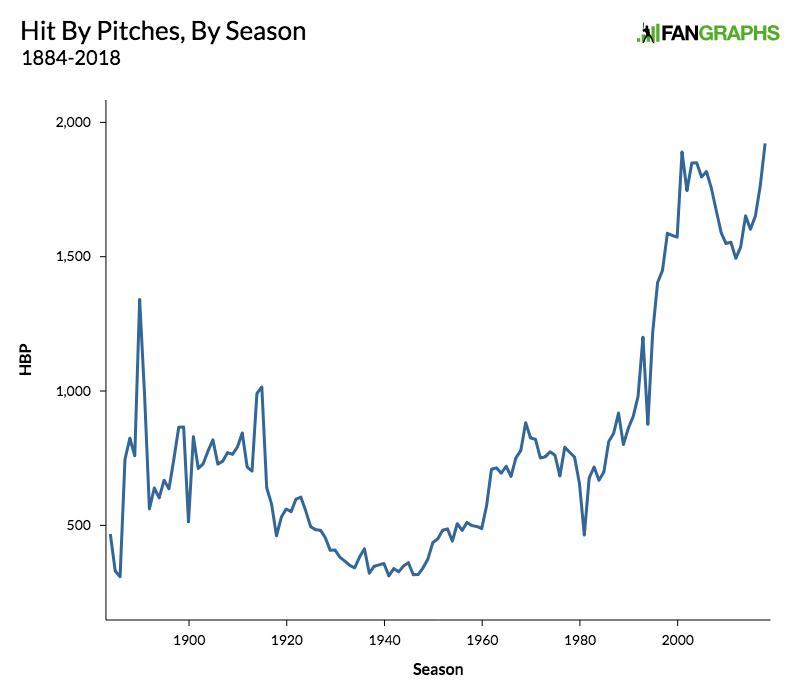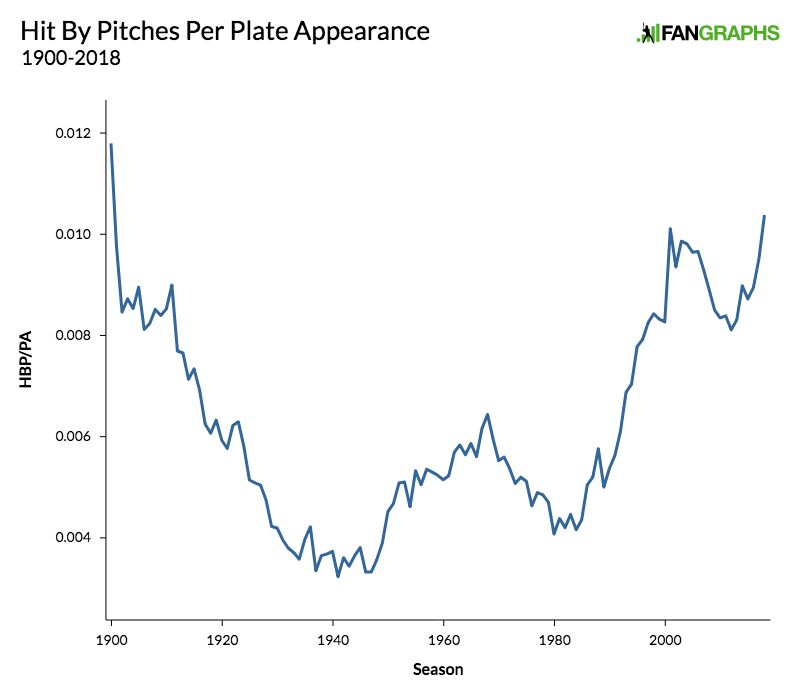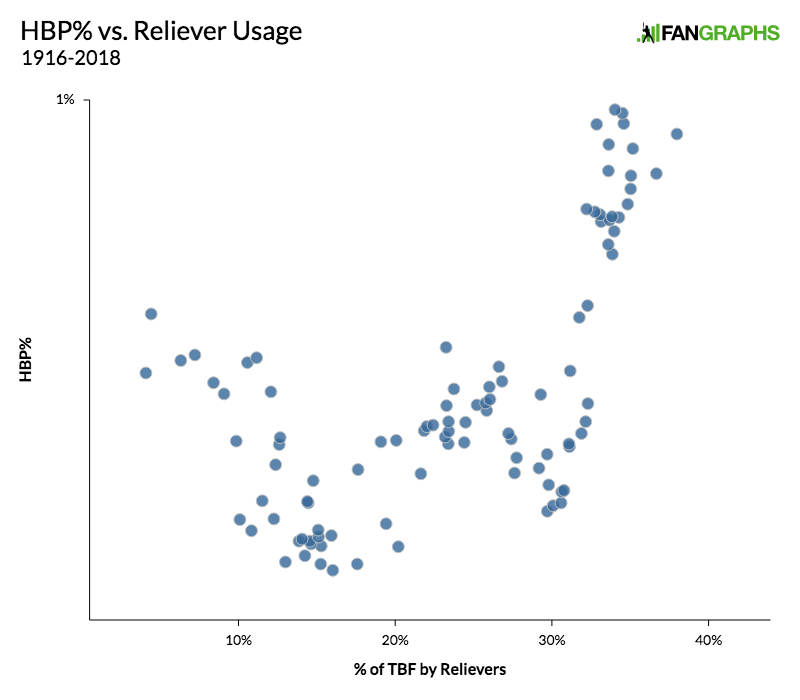The Hit-By-Pitch Continues to Reach New Heights
The hit-by-pitch, as we know it today, predates the American League itself. It was in 1887, a good 14 years before the founding of baseball’s Junior Circuit, that the rules of this sport were amended to award a runner first base when hit by a pitcher’s usually-errant toss to home plate. (Interestingly enough, though, the statistic of a “hit-by-pitch” has been kept since 1884.)
Today, the hit-by-pitch generally flies under-the-radar. Of course there is the notable exception, the retaliatory hit-by-pitch, which does rear its ugly head around every few weeks. And we do often find ourselves talking about a hit-by-pitch when it unfortunately injuries one of our favorite players. But, other than that, it’s an event that just happens. There’s not much else to it.
Or so I initially thought. As the years have gone by, hit-by-pitches have been slowly increasing, and it really hasn’t gathered much attention from the greater baseball community. The 2018 season saw an all-time high in hit batsmen with 1,922. And in 2019, we are on pace to break the 2,000 mark for the first time in baseball’s history.

Clearly there’s been a huge rise in hit-by-pitches in recent decades. In 1994, baseball saw just a total of 876 hit batsmen, the last year (to date) that the league sat under 1,000. Since that time, the total number of batters hit has increased by 43.6 per year, on average, and no end to this growth appears to be in sight.
Now let’s take a look at the number of hit batsmen per plate appearance:

Here again we see a huge spike in recent decades, informing us that this is indeed a long-term trend, though it is interesting to see that late-1800s baseball featured a lot of hit batsmen. Historians don’t consider any seasons pre-1900 to be considered part of baseball’s “modern” era, so let’s narrow the scope of the graph down ever-so-slightly to just include post-1900 baseball:

The year 1900 is clearly the outlier here, but as you can see in the graph, baseball’s hit-by-pitch per plate appearance rate didn’t even reach 0.01 (or 1% of plate appearances) from 1901 all the way until 2001, a 101-year span. In 2018, baseball’s hit batsmen per plate appearance rate was the highest it has been since the 1900 season, and in 2019 so far, we’ve come even closer to reaching that ceiling. In fact, eight of baseball’s 10 top HBP% seasons have come in the last 18 years:
| Season | HBP% |
|---|---|
| 1900 | 1.180% |
| 2019 | 1.113% |
| 2018 | 1.038% |
| 2001 | 1.011% |
| 2003 | 0.986% |
| 2004 | 0.981% |
| 1901 | 0.976% |
| 2006 | 0.966% |
| 2005 | 0.965% |
| 2017 | 0.951% |
There’s definitely something going on here. Upon seeing these figures, my first theory was that due to the increase in velocity, pitchers have a harder time controlling their pitches. This, in turn, would lead to the increase in hit-by-pitches.
In order to test this theory, I used Statcast data to break down every single hit-by-pitch from the 2018 season by velocity. I then created buckets of velocity, focusing on the higher-echelon velocities.
| Pitch Speed (mph) | HBP | % of HBP | % of Total Pitches |
|---|---|---|---|
| 97-100+ | 62 | 4.3% | 4.6% |
| 95-96 | 83 | 5.8% | 6.9% |
| 93-94 | 159 | 11.0% | 10.3% |
| 91-92 | 167 | 11.6% | 10.6% |
| 0-90 | 972 | 67.4% | 67.7% |
As you can see, the data doesn’t lead to a clear conclusion. The buckets pretty closely align in terms of percentage of hit batters and pitch percentage, potentially suggesting that velocity has a minimal, if any, impact on hit-by-pitches.
What does appear to be more interesting, however, is the breakdown of hit-by-pitches by type of pitcher: starter vs. reliever. Check out the data:
| Type of Pitcher | HBP | % of HBP | % of Total Pitches |
|---|---|---|---|
| Starting Pitcher | 1095 | 57.0% | 59.4% |
| Relief Pitcher | 827 | 43.0% | 40.6% |
In 2018, relief pitchers were responsible for 2.4 percentage points more of the hit-by-pitch share than what we’d expect them to produce. This led me to think of a second theory: the increase in relief pitcher innings thrown is responsible for the increase in hit batters. Let’s take a look at a potential correlation between the percent of total batters faced (a stat since 1916) by relief pitchers and the HBP% in that given year.

There’s actually a decent correlation here, though it’s not quite linear. There’s some noise on both sides, and I think part of this could be due to one main factor. In the early 1900s, baseball featured a fair amount of hit-by-pitches (as seen above) but did not have many relievers. Guys just threw, and I think that this contributes to the shape that we see here.
The “modern” reliever didn’t become prominent in the majors until about 1970. So let’s do what I did above and limit the scope of our data, focusing on 1970 to the present:

Now we begin to see a stronger correlation between HBP% and reliever usage. This scatter plot has an R-value of .761 and an R-squared of .579. Of course, correlation does not necessarily mean causation, so we can’t conclude that the increase in relievers is responsible for the increase in hit-by-pitches, but it is still an interesting theory.
Finally, let’s combine the two thoughts into one. There might be something hidden in the data, something that tells us that velocity might still play an important factor in hit-by-pitches, but perhaps the phenomenon is more prominent among relief pitchers:
| Pitch Speed (mph) | HBP | % of HBP at Speed | % of Pitches at Speed |
|---|---|---|---|
| 97-100+ | 45 | 72.6% | 64.9% |
| 95-96 | 41 | 49.4% | 53.6% |
| 93-94 | 74 | 46.5% | 44.9% |
| 91-92 | 58 | 34.7% | 36.0% |
| 0-90 | 408 | 42.0% | 36.6% |
Here again, the data doesn’t let us conclude anything concrete. Relievers are certainly more responsible for more than their “fair share” of hit-by-pitches at the fastest speeds, but beyond that, there’s not a whole lot there that may suggest relievers’ hard-throwing pitches are the ones responsible for the hit-by-pitch spike.
After all of this analysis, there are a couple main takeaways that are worth reiterating. First, hit-by-pitches are clearly on the rise. Since the 1980s, we have seen more hit-by-pitches than ever before, and on a percentage basis, pretty much the most since the modern era began. That’s a big deal. Second, relievers could be the main culprit of this growth for two main reasons: 1) they have hit more batters than what would be expected and 2) there’s a strong correlation between percent of batters faced by relievers and hit-by-pitches. Finally, the increase in velocity doesn’t necessarily contribute to this; it’s inconclusive as to whether baseball’s fastest pitches create more hit-by-pitches than those that are slower.
Nonetheless, as everyone else focuses on strikeouts, walks, and home runs, I’m going to continue to be watching this. The race to 2,000 hit batsmen in a season is on, and 2019 seems like it could be the year that baseball breaks its own record yet again.
Devan Fink is a Contributor at FanGraphs. You can follow him on Twitter @DevanFink.

And Brandon Guyer has barely even played the past few years!